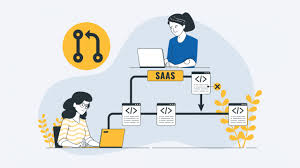9 Steps in the SaaS Product Development Process
The Software as a Service (SaaS) model has revolutionized the way businesses operate, allowing for scalable, accessible, and cost-effective solutions. Developing a successful SaaS product requires a well-structured approach, encompassing multiple phases from idea conception to ongoing maintenance. This article outlines the nine essential steps in the SaaS product development lifecycle, emphasizing best practices and methodologies such as Agile development, while also showcasing the role of companies like Kryoverse Innovation in streamlining this process.
Step 1: Ideation and Market Research
The first step in the SaaS development lifecycle is to generate ideas based on market needs. This involves thorough market research to identify gaps, target audiences, and potential competitors. Conduct surveys, focus groups, and interviews to gather insights directly from potential users. Understanding user pain points and preferences will guide your product’s functionality and design. Utilizing analytics tools can also help in assessing market trends, ensuring your product meets real demands.
Step 2: Defining Requirements
Once you have a clear understanding of the market landscape, the next step is to define the requirements for your SaaS product. This involves creating detailed user stories and use cases that illustrate how users will interact with your application. Prioritize features based on user needs and business objectives. Collaborating with stakeholders, including product managers and potential users, is crucial during this phase to ensure that all requirements are captured accurately.
Step 3: Prototyping
Creating a prototype is an essential step that allows you to visualize the product before full-scale development begins. Prototyping can take various forms, from low-fidelity wireframes to high-fidelity interactive models. This stage is critical for gathering early feedback from stakeholders and potential users, allowing you to make necessary adjustments before moving into development. Tools like Figma or Adobe XD can facilitate the prototyping process.
Step 4: Agile Development
Agile methodologies have become the gold standard for SaaS product development, allowing teams to work in iterative cycles (sprints). This approach promotes flexibility and continuous improvement. During this phase, developers will write code, integrate features, and conduct regular testing to ensure functionality aligns with user requirements. The Agile framework encourages collaboration among cross-functional teams, fostering an environment where feedback is quickly implemented.
Step 5: Testing
Quality assurance (QA) is paramount in the SaaS development lifecycle. Testing should begin as early as possible and continue throughout development to identify and resolve bugs. Various types of testing, including unit testing, integration testing, and user acceptance testing (UAT), are critical to ensuring a reliable product. Automated testing tools can help streamline this process, allowing for faster iterations and more consistent results.
Step 6: Deployment
Once testing is complete, the next step is deployment. This involves moving the application to a live environment where users can access it. Proper deployment planning includes strategies for data migration, system configurations, and user training. It’s important to monitor the deployment process closely to address any issues that may arise quickly. Consider using cloud platforms like AWS or Azure for hosting, which can provide scalability and reliability.
Step 7: User Onboarding
User onboarding is a critical component of the SaaS product lifecycle. A smooth onboarding process helps users acclimate to the application, increasing the likelihood of retention and satisfaction. Create intuitive tutorials, walkthroughs, and help documentation to assist users in navigating your software. Gathering feedback during this stage is also vital for understanding user experience and identifying areas for improvement.
Step 8: Maintenance and Updates
Post-launch, continuous maintenance and updates are crucial for the longevity of your SaaS product. Regular updates improve security, add new features, and fix bugs, keeping your application relevant in a competitive market. Establish a feedback loop with users to gather insights for future updates. Utilizing analytics tools can also help you monitor user behavior and identify which features are most valuable.
Step 9: Marketing and Growth Strategies
After launching your SaaS product, effective marketing is essential for growth. Develop a comprehensive marketing strategy that includes SEO, content marketing, social media engagement, and email campaigns to attract and retain users. Consider leveraging partnerships and collaborations to expand your reach. Continuous evaluation of your marketing efforts will help you refine your strategy and maximize user acquisition.
The Importance of the SaaS Development Lifecycle
The SaaS development lifecycle is a structured approach that ensures product quality, user satisfaction, and business growth. Each step is interrelated, creating a holistic framework that promotes collaboration and efficiency. Emphasizing Agile development methodologies allows teams to adapt quickly to changes, ensuring the final product aligns with user needs.
The Role of Kryoverse Innovation
Partnering with experienced companies like Kryoverse Innovation can significantly enhance the SaaS product development process. Kryoverse specializes in innovative solutions that streamline the development lifecycle, offering expertise in market research, prototyping, and Agile methodologies. Their approach combines technical skills with a deep understanding of user experience, ensuring that your SaaS product not only meets but exceeds market expectations.
Kryoverse Innovation can also assist with scalability, providing insights into cloud infrastructure and data management, crucial for any successful SaaS application. By leveraging their experience, you can navigate the complexities of SaaS development more efficiently, ultimately reducing time-to-market and improving your product’s chances for success.
Conclusion
Developing a successful SaaS product involves navigating a multifaceted process that requires careful planning, execution, and ongoing adaptation. By following these nine steps—from ideation and market research to user onboarding and growth strategies—you can create a product that resonates with users and stands out in a crowded marketplace. The SaaS development lifecycle is not just a series of steps; it’s a dynamic journey that, when approached strategically, can lead to long-term success and customer satisfaction. Embracing best practices and methodologies like Agile, alongside the support of industry experts like Kryoverse Innovation, will enhance your product’s potential, ensuring it meets the ever-evolving needs of the market.














Post Comment